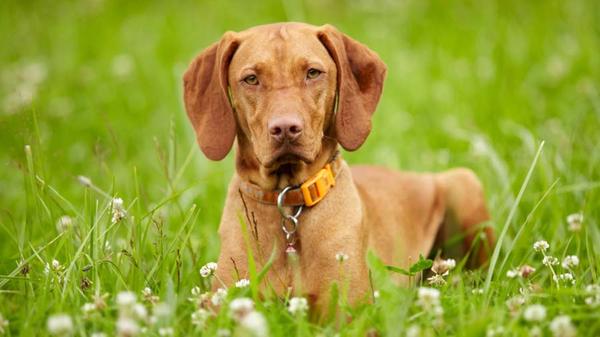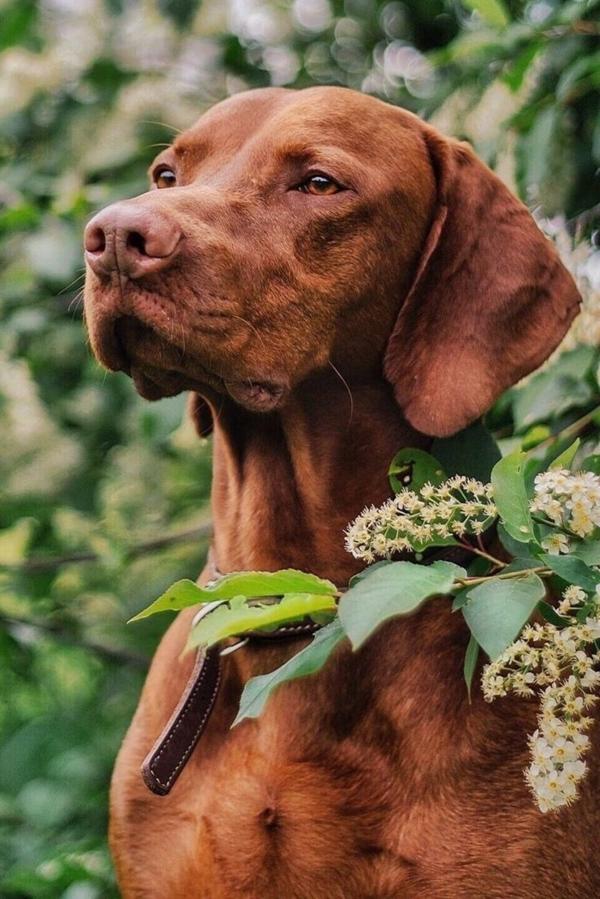Vizsla
also known as Hungarian Short-Haired Pointer, Magyar Vizsla, Hungarian Pointer, Hungarian Vizsla, Rövidszőrű Magyar Vizsla

 History
History
The Vizsla, also known as the Hungarian Vizsla or the Hungarian Pointer, is a beautiful and versatile breed with a storied past dating back to the 9th century. These dogs were developed in Hungary as a hunting companion, prized for their exceptional sense of smell, speed and endurance, and their trainability.
The origins of the Vizsla can be traced back to the 9th century, when they were used by the Magyar tribes of Hungary as hunting dogs. They were valued for their excellent sense of smell and ability to hunt small game such as hares, foxes, and birds. Vizslas were primarily owned by the sporting nobility of Hungary and were used to scent and search for birds that were then caught by falcons or netted. This made them highly prized by the nobility and they were often used to hunt in the royal hunting grounds.
The breed was officially recognized by the Hungarian Kennel Club in 1884, and later on by The Kennel Club (UK) in 1950, the American Kennel Club (AKC) in 1960, and the Canadian Kennel Club (CKC) in 1960. The breed name "Vizsla" means "pointer" in Hungarian, referring to the dog's ability to point out game to the hunter, a skill that was highly valued by the nobility.
The Vizsla is a versatile and adaptable breed that excels in a variety of roles. While they are known for their excellent hunting abilities, they are also great companions for sportsmen, hunting enthusiasts and families. They have a great sense of smell, endurance and are able to work in different terrains and conditions, which makes them suitable for different types of activities such as hunting, agility, search and rescue, therapy, and as a loving companion. They are also known for their natural pointing and retrieving instincts which makes them great at hunting different types of game.
During the 20th century, the Vizsla population was decimated by two World Wars and the Russian invasion of Hungary. After World War I, only about a dozen dogs remained and these became the basis of all registered Vizslas in Hungary. Many nationals fled during the Russian occupation, taking their Vizslas with them, and the breed was established in Europe and the West.
Breed Information
Is Vizsla a purebred?
Purebred
How do you pronounce the Vizsla name? How do you say Vizslas?
VEEZH-lah
What were Vizslas originally used for?
Pointing, Falconry, Trailing
How Long Do Vizslas Live? What is average life expectancy for a Vizsla? How long can Vizslas live?
10-14 years
The average Vizsla lifespan is somewhere between 10-14 years, provided they aren't beset by any exceptional health issues or injuries.
Vizsla Height & Weight
How big is a full grown Vizsla?

| Height | ||||
|---|---|---|---|---|
| Average | 6 months | 12 months | 18 months | |
| Male | 22-24 inches (55.9 - 61 cm) | 19.0 inches (48.3 cm) | 21.0 inches (53.3 cm) | 23.0 inches (58.4 cm) |
| Female | 21-23 inches (53.3 - 58.4 cm) | 18.0 inches (45.7 cm) | 20.0 inches (50.8 cm) | 22.0 inches (55.9 cm) |
| Weight | ||||
|---|---|---|---|---|
| Average | 6 months | 12 months | 18 months | |
| Male | 55-60 pounds (25 - 27 kg) | 27.5 pounds (12 kg) | 40.0 pounds (18 kg) | 57.5 pounds (26 kg) |
| Female | 45-55 pounds (20 - 25 kg) | 22.5 pounds (10 kg) | 35.0 pounds (16 kg) | 50.0 pounds (23 kg) |
Do Vizslas get fat easily?
![]()
![]()
![]()
![]()
![]()
The Vizsla is a dog breed that has a low to average risk for obesity. This means that they are less likely to gain weight than some breeds, but it is still important to monitor their food intake and ensure they get enough exercise to maintain a healthy weight and overall well-being.
Are Vizslas Hypoallergenic?
No
Unfortunately, the Vizsla is not hypoallergenic, making it not a good choice for a dog lover who suffers from pet allergies.
What is a Vizsla personality? What are Vizsla dogs best known for?
Affectionate
Energetic
Intelligent
Protective
Cheerful
Gentle
Playful
Quiet
Easygoing
Companionable
Lively
Friendly
Evenly Tempered
Trainable
Willing
Are Vizslas heavy shedders? How Much Does a Vizsla Shed?
![]()
![]()
![]()
![]()
![]()
Vizsla dogs are not heavy shedders, but they will lose a significant amount of hair each year. To decrease the amount of shedding, you can regularly brush your Vizsla. This will remove loose hair and keep his coat growing in the same direction.
What is the watchdog ability of a Vizsla dog?
![]()
![]()
![]()
![]()
![]()
The Vizsla dogs are average watchdogs. If they sense something different, this breed will alert their owner.
Breed History
Where do Vizslas come from?
Hungary
What are Vizslas descended from?
Turkish Yellow Dog, Transylvanian Hound, Weimaraner
What organizations or kennel clubs recognize/register the Vizsla breed?
American Canine Registry
American Kennel Club
America's Pet Registry
Canadian Kennel Club
Dog Registry of America Inc.
Federation Cynologique Internationale
Kennel Club of Great Britain
North American Purebred Registry, Inc.
American Canine Association, Inc.
Australian National Kennel Council
Continental Kennel Club
National Kennel Club
New Zealand Kennel Club
United Kennel Club
When were Vizslas first bred? How old is the Vizsla breed?
Middle Ages
What Breed Group is a Vizsla?
Sporting (AKC:1960)
Gun Dogs (UKC)

Vizsla Appearance
What color are Vizsla eyes?
Brown
What color can Vizsla nose be naturally?
Brown
What color can Vizsla coat be naturally?
Fawn
Red
How long is a Vizslas coat?
![]()
![]()
![]()
![]()
![]()
The coat of a Vizsla dog ranges in length from short to medium.
How Dense Is The Vizsla Coat?
![]()
![]()
![]()
![]()
![]()
What is the texture of the hair of a Vizsla?
Straight
How many puppies can a Vizsla have in a litter? How many puppies can a Vizsla have in her first litter?
10-14 puppies per pregnancy
A Vizsla can have a litter of 10-14 puppies on average. However, it's worth noting that the size of the litters can vary greatly. Factors that can influence litter size include the health of the mother, breeding history, and genetics.
![]()
![]()
![]()
![]()
![]()
Vizslas are known for their adaptability and versatility, they are capable of adapting well to a wide range of lifestyle changes and living environments. They are a highly adaptable breed, and make great companions for families and individuals of all lifestyles.

Vizsla Health Issues
Do Vizslas have a lot of health problems?
![]()
![]()
![]()
![]()
![]()
The Vizsla is generally considered to be healthy. However, like all breeds, they are susceptible to certain health issues and it is important to keep an eye out for them and address them with your veterinarian as needed.
What are the major health concerns to be aware of when owning a Vizsla?
Progressive Retinal Atrophy
Epilepsy
Hypothyroidism
Lymphoma
Tricuspid Valve Dysplasia
What are the less significant issues to keep in mind when it comes to Vizslas?
Allergies
Bacterial and Viral Infections
What are the occasional tests recommended for Vizsla breed?
Blood Test
Heart
Thyroid Tests
Eye Examination
Physical Examination
Allergy Tests

Vizsla Needs and Activities
Do Vizslas have a lot of energy?
![]()
![]()
![]()
![]()
![]()
Vizslas are high-energy dogs, thus an active lifestyle suits them well.
Do Vizslas need socialization? How social are Vizslas?
![]()
![]()
![]()
![]()
![]()
Vizsla have above average social needs compared to other breeds.They thrive in environments where they have a lot of interaction with humans and other dogs.
How much exercise should Vizslas get?
![]()
![]()
![]()
![]()
![]()
The Vizsla needs a high level of physical activity to maintain a healthy lifestyle. They also make great companions for people who lead an active lifestyle and enjoy running, hiking or other outdoor activities. These breeds are not suitable for people with sedentary lifestyle or those who live in small apartments
How much sleep should a Vizsla have? Do Vizslas sleep a lot?
![]()
![]()
![]()
![]()
![]()
Vizslas are active dogs that don't require as much sleep as other breeds. However, they still need enough sleep to stay healthy.
Does a Vizsla drool a lot?
![]()
![]()
![]()
![]()
![]()
The Vizsla is a breed of dog that is characterized by its minimal drooling, making it an ideal choice for people who dislike drool marks on their clothing.
How much does it bark?
![]()
![]()
![]()
![]()
![]()
Vizslas tend to bark moderately, they bark when necessary, such as to alert their owner or to communicate something. They may also bark due to certain triggers like fear, alarm, boredom, greeting, separation anxiety and compulsive barking.
Do Vizslas exhibit aggressive behavior to safeguard their home and territory? Do they possess a natural tendency to guard?
![]()
![]()
![]()
![]()
![]()
Vizsla dogs are known for being average at defending. They possess the capability to defend their territory or owners, but it is not their primary trait. They are not the best choice for guard dogs
Are Vizslas mouthy?
![]()
![]()
![]()
![]()
![]()
What is the likelihood of a Vizsla running away? Do they have a tendency to explore or wander frequently?
![]()
![]()
![]()
![]()
![]()
Do Vizsla dogs have a high prey drive?
![]()
![]()
![]()
![]()
![]()
What do Vizslas enjoy doing? How do I keep my Vizsla busy?
Fetch, Tug-of-war, Pulling, Saying hi, Walking, Petting, Boat ride, Run, Swim, Hunt, Tracking, Sniffing, Dog Parks, Cuddle, Play, Belly rubs, Jumping, Kisses, Running, Kissing, Chewing, Cuddling, Ball chasing, Power walking, Playing chase, Fetching, Casual walking, Skateboarding, Hiking, Frisbee
What is the energy level of a Vizsla? How much energy does a Vizsla have?
High
Vizslas are high-energy dogs. They need mental as well as physical exercise. These dogs require a lot of your involvement and without it they can, and will, become problematic dogs.
![]()
![]()
![]()
![]()
![]()
How far should a Vizsla walk each week? How many miles should a Vizsla walk every week?
14 miles / week
There's really no limit to how far you walk your dog as long as they're comfortable. For Vizsla, it's at least 14 miles / week. Just remember to build distance and stamina gradually over time.
How much a Vizsla should exercise a day? How much activity does a Vizsla need?
90 minutes
In general most Vizslas usually need at least 90 minutes of exercise daily. This can be spread across the day and include all sorts of high-energy activities, like walking, running and playing.
What level of grooming should be provided for a Vizsla?
![]()
![]()
![]()
![]()
![]()
The Vizsla is a breed of dog that does not require extensive grooming.
How often should you brush a Vizsla?
Weekly
Vizsla should be brushed at least once a week. Of course you can give them more frequent brushes if you find that they are still shedding a lot
What are the most commonly used brushing tools for Vizslas?
Slicker Brush
Nail Clipper
Costs
How many cups of food does a Vizsla eat?
3 cups
For an average 55-60 pound (25 - 27 kg) Vizsla feed 3 cups daily. But, keep in mind, the amount you feed is going to be dependent on the quality of the food you are feeding.
How Much Does a Vizsla Cost Daily?
$1.70 - $2.00 / day
The average cost of a Vizsla is somewhere $1.70 - $2.00 per day.
How Much Does a Vizsla Cost Per Month?
$48 - $63 / month
The average per month expenses of a Vizsla is between $48 - $63. This makes an average of $576 - $756 per year. It will be on the higher side when the dog is still small because it will need more frequent visits to the vet, shots.
Vizsla Characteristic
How intelligent is a Vizsla?
![]()
![]()
![]()
![]()
![]()
The Vizsla breed is considered very intelligent and easy to train.
How sensitive is a Vizsla dog?
![]()
![]()
![]()
![]()
![]()
This dog breed is particularly attuned to its environment and the emotions of those around it. It can be easily overwhelmed by loud noises, new environments, and unfamiliar people or animals. This dog is best suited for individuals or families who are patient, gentle, and understanding of its sensitive nature. It may also benefit from a calm and stable home environment, with a consistent routine and plenty of positive reinforcement training.
Are Vizsla dogs affectionate?
![]()
![]()
![]()
![]()
![]()
Do Vizsla do well in apartments? Are Vizslas good indoor dogs?
![]()
![]()
![]()
![]()
![]()
It's not recommended to keep the Vizsla in an apartment, but this breed make good apartment dogs as long as they get to spend a good amount of time outside of the apartment. Vizslas living in apartments will need plenty of physical exercise and stimulation throughout the day to remain happy and well-behaved.
Are Vizslas good with kids? Are Vizslas good around children?
![]()
![]()
![]()
![]()
![]()
Vizslas are kid-friendly dogs. They are good with children and excellent dogs with children if they are socialized and trained at a young age.
Are Vizslas good for elderly?
![]()
![]()
![]()
![]()
![]()
Are Vizslas good with cats? How friendly Vizslas are toward cats?
![]()
![]()
![]()
![]()
![]()
Vizslas are an average cat friendly dog. They do well with cats, even more if raised together from puppyhood,
Do Vizsla dogs get along with other dogs? Are Vizslas OK with other dogs?
![]()
![]()
![]()
![]()
![]()
Vizslas are average friendly towards other dogs. If they are raised with other dogs, they are likely to get along with them. And, if they are socialized properly from a young age, they will usually be great with other dogs.
How do Vizsla dogs interact with other pets? Are they considered pet-friendly?
![]()
![]()
![]()
![]()
![]()
Are Vizslas friendly with strangers?
![]()
![]()
![]()
![]()
![]()
Vizslas are average friendly around strangers. They can be wary around strangers and a little standoffish. Early socialisation is key.
Do Vizslas like to play? Are Vizslas playful?
![]()
![]()
![]()
![]()
![]()
Vizslas are known to be highly playful dog. So if you're not up for all that, think about adopting a slightly older Vizsla for a mellower experience.
Are Vizsla easily trained?
![]()
![]()
![]()
![]()
![]()
Vizsla dogs are known for their ease of training and ability to learn quickly, making them a popular choice for pet owners and trainers alike.
 Pros & Cons
Pros & Cons
Pros
- Maintain a healthy weight
Vizslas are at a low to average risk for becoming obese. - Affectionate
The Vizsla is known to be affectionate and loyal towards its owners. - Therapy Dog
Therapy dog tasks are well within this breed's capabilities. - Boat Dog
The Vizsla breed is often at home on boats. - Versatile
The Vizsla is a versatile breed that excels at hunting, retrieving, and agility.
Cons
- High energy
The Vizsla has a lot of energy and requires regular exercise to prevent boredom and destructive behavior. - Not Apartment Friendly
Keeping a Vizsla inside the home is not recommended. - Not Hypoallergenic
Due to their non-hypoallergenic nature, Vizslas may cause allergic reactions in some people. - Not suitable for office environment
An office is not the best place for a Vizsla. - Prone to certain health issues
The Vizsla is prone to certain health issues such as hip dysplasia and bloat.